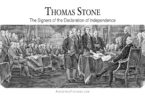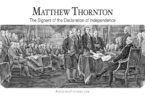Richard Stockton was born in 1730 in the Stony Brook neighborhood of Princeton, New Jersey. As the son of a wealthy landowner named John Stockton, Richard had a comfortable and privileged upbringing. His father, in fact, donated land for what became Princeton University (originally called the College of New Jersey), and helped bring the university to New Jersey.
As a child, Richard attended the academy operated by Samuel Finley at Nottingham, that later became the West Nottingham Academy. He also attended the nascent Princeton University (operating under its original name), graduating from it in 1748. After graduation, Richard studied law with the head of the legal profession in New Jersey, a man named David Ogden in the city of Newark. Richard was admitted to the bar in 1754, and quickly achieved great success. Richard achieved the degree of Sergeant at Law in 1763, which was the highest degree of law at the time.
Though he had been personal friends with George Washington for some time when he achieved his legal successes, Richard showed little interest in entering politics at first. This was a bit unusual, as many lawyers of the time used the profession as a springboard to a political career. In fact, Richard once famously wrote,
“The public is generally unthankful, and I never will become a Servant of it, till I am convinced that by neglecting my own affairs I am doing more acceptable Service to God and Man.”
Instead of politics, Richard used his free time to be an active member of the Board of Trustees at the College of New Jersey.

In fact, Richard served the college for twenty-six years. He gave up his law practice in 1766 and 1767 to visit England, Scotland, and Ireland. He already had a substantial amount of fame in the legal profession then, and this fame preceded him on his voyage. Because of this, Richard was received by the most important and famous men in Great Britain at that time. He was able to personally present King George III with an address of the trustees of the College of New Jersey, where he acknowledged the repeal of the Stamp Act. The king favorably received this address. Richard was also consulted on the state of American affairs by notable British men such as the Marquess of Rockingham and the Earl of Chatham, as well as other distinguished members of Parliament who were friendly to American interests.
Upon returning to America in the summer of 1767, Richard soon had his first political experience when he was promoted to a seat in the New Jersey Provincial Council in 1768. That same year, he was elected to the American Philosophical Society. Later, in 1774, Richard was appointed to the New Jersey Supreme Court.
When tensions first arose between Great Britain and the American colonies, Richard favored a moderate approach. He wrote a plan of self-government for America, where it would be independent of Parliament, but still loyal to the king. The king did not accept this proposition. If he had, war with the colonies could have been avoided.
Richard was appointed to the Second Continental Congress in 1776. Once there, he took a quite active role among the other delegates. In fact, he became the first person from New Jersey to sign the Declaration of Independence. After signing it, the Congress sent Richard, along with a fellow signer named George Clymer, on a two-month journey to Fort Ticonderoga, Saratoga, and Albany, New York to assist the Continental Army in the American Revolution.
Once that errand was done, Richard traveled thirty miles east on the way back to the Congress to evacuate his family to safety. While doing this, he stayed with a friend named John Covenhoven. In November of 1776, while at John’s house, Richard and John were dragged from their beds by British loyalists one night, stripped of their property, marched to Perth Amboy, and turned over as prisoners to the British. The day that happened, British General William Howe had written a proclamation that offered protection papers and a full and free pardon to anyone who was willing to stay in peaceful obedience to the king. Many prisoners took this offer, and, after being put in irons and treated as a common criminal by his captors, Richard did, too.
While imprisoned, Richard was starved on purpose and subjected to freezing weather. He took the offer of freedom after five weeks of this treatment, but his health was ruined by the experience. Also, his home in Princeton was occupied by General Charles Cornwallis when he was released, so he couldn’t go home. Though he took the pardon offer, his signed acceptance was never submitted to the king, as he was a signer of the Declaration of Independence and a leader of the American rebels. When all the members of the Continental Congress and the Continental Army were required to take the oath of allegiance to the new United States in 1777, Richard did so, and did not turn in any British protection papers, as he would have been required to do if he had actually signed General Howe’s proclamation and been given an official pardon. It seems that Richard’s release was a spoken agreement only, and never committed to writing.
After leaving the Continental Congress, Richard went home to re-open his law practice and to teach new law students. Richard was able to recover his health for the most part, but in 1779, developed a tumor on his lip that later went to his neck, and he crossed to the other side at the age of fifty in 1781. As per his written wishes, he was buried at the Stony Brook Meeting House Cemetery in Princeton, as two generations of his family had been Quakers. Today, he is one of only six signers of the Declaration of Independence to have a statue of them at the National Statuary Hall Collection at the US Capitol building. In 1969, New Jersey established a state college to be named after Richard. After several name changes, it is now known as Stockton University.
As for his family, Richard married Annis Boudinot, one of early America’s only published female poets. Annis was one of George Washington’s favorite correspondents after Richard crossed to the other side. Together, Annis and Richard had six children, four daughters and two sons. Both sons went into politics, following in their father’s footsteps.






